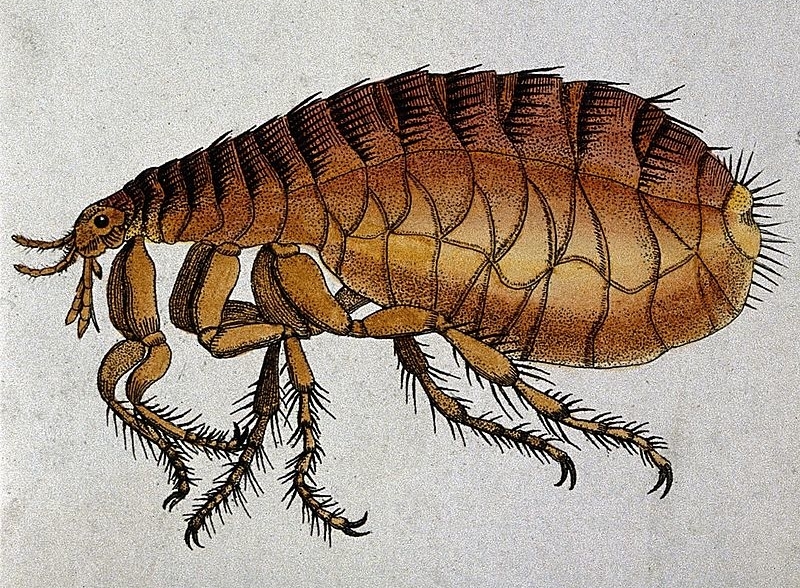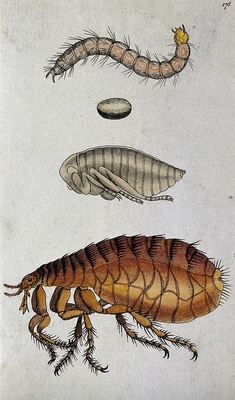This article will arm you with information needed to implement a comprehensive plan for ridding your home of pesky fleas. I will cover immediate steps you need to take, as well as lay out a longer-term strategy for lasting results.
To permanently get rid of fleas in your home, I recommend the following plan of attack:
- Immediate Tactics:
- Vacuuming areas ripe for flea breeding
- Washing and/or replacing pet bedding
- Chemically treating the inside of your home
- Bathing and treating pets for fleas
- Longer-Term Strategy:
- Repeat indoor treatments for the entire duration for the flea life cycle
- Identify and control the flea source
- Implement preventative measures
Ridding your home of fleas can be a challenge! There are many tips and tricks on how to kill fleas. Following a few basic steps, you may win the battle against existing fleas. But the key to permanently winning the war against fleas is to ‘know thy enemy’. In this article, I will arm you with information about how fleas operate, so you can implement a complete strategy for living flea-free!
You may also be interested in reading these two related articles “How To Get Rid Of Head Lice” and “How To Get Rid Of Boxelder Bugs“.
Winning The Battle: The Current Infestation
Start With A Good Cleaning
Fleas lay eggs in cracks and crevices where pet hair, dander and dust can collect. One such place is on top of and around baseboards. In addition, carpets, pet bedding, and upholstered furniture are locations ripe for fleas. A thorough vacuuming with special focus on these areas is the first step in your plan of attack. Once done, be sure to replace your vacuum bag or wash your vacuum canister in order to discard all extracted fleas.
Wash Or Replace Pet Bedding And Linens
If replacing pet bedding is not practical, laundering blankets and bed covers is a good alternative. Linens should be washed with the hottest water and dried on the highest heat setting that is allowed for the fabric being laundered. Be sure not to forget about pet toys! Wash them thoroughly. Any stuffed toys should either be thrown out or washed along with your pet linens.
Chemically Treat Your Home For Fleas
After a thorough cleaning, your home will be ready to be chemically treated. These treatments will narrow in on active adult fleas left behind after your cleaning. There are several products available on the market, but I have had the best results with Dragnet SFR. This product is extremely effective. The residue makes adult fleas sterile, preventing additional flea eggs from being laid before the flea dies.
Apply Dragnet SFR per the bottle instructions to your floors, baseboards, carpets/rugs, pet bedding, and any upholstered furniture where fleas are suspected. Once the chemical has dried thoroughly, it is safe for pets and humans to resume normal activities on the treated areas.
Treat Your Pets For Fleas
Before reintroducing pets to your flea-treated home, you need to ensure they are flea-free. Start with a thorough wash to remove as many fleas as possible from your pet. After your pet is completely dry, apply a topical treatment such as Frontline Plus. This product is effective at treating fleas at various stages of their life cycle (eggs through adults). Treat them per the bottle instructions, which typically involves applying to pet’s skin between their shoulder blades.
Winning The War: Strategy For A Flea-Free Life
Repeat Indoor Treatments For Duration Of The Flea Life Cycle
The key to permanently winning the war against fleas is understanding the flea life cycle and attacking them at the right stage. Similar to a caterpillar, a flea goes through a complete metamorphosis. The four life stages of a flea include: egg, larva, pupa and adult.
Treatments such as Dragnet SFR are effective against adult fleas, but do not combat fleas that have not hatched or have not exited their pupa cocoons. You will need a treatment strategy that addresses the fleas as they progress through the full metamorphic cycle (2-3 weeks in typical home environments).
Continue vacuuming regularly (daily if possible) to extract as many fleas as possible before they reach adulthood. Repeat Dragnet SFR treatments every week over a 3 week period. This includes retreating floors, baseboards, carpets, upholstery and pet bedding that is in the vicinity of the original infestation. This serves to target any fleas that avoid extraction and make it to the adult stage (when the biting begins).
Activate The Troops
Young adult fleas must feed immediately once they exit their pupa cocoon. As such, they wait for external, environmental triggers such as light, heat or vibration to initiate their exit. The close proximity of pets and humans typically activates this. But for fleas in vacant homes (and even rooms of your home that are closed off), the pupae can lie dormant for up to a year.
If you are dealing with a flea infestation, you need to ensure fleas do not remain dormant. Rooms used infrequently should not be closed off and should be vacuumed regularly. Vibration from vacuuming is often enough to activate pupae.
Identify And Control The Flea Source
Identifying the original source of flea exposure is important. Household pets can pick-up fleas when they come into close contact with other infected animals (e.g. dog park, pet boarding). However, for infected pets that do not venture away from home, the source may be your own backyard.
It is virtually impossible to rid your yard of all fleas, but you can significantly reduce fleas and even deter your pets from loitering in infested areas with appropriate flea control measures. Keeping your yard neat and tidy, keeping grass short, controlling overgrowth in flowerbeds, and not allowing fallen leaves to accumulate will go a long way to minimizing fleas in your yard. (Dragnet SFR can also be applied outdoors on lawns and shrubs when needed.)
An Ounce Of Prevention Is Worth A Pound Of Cure
It is significantly easier to prevent future flea infestations than it is to eliminate an existing one. You know the saying, “An ounce of prevention is worth a pound of cure.” Once your flea infestation is under control, taking preventative measures will serve you well.
Even when you are not battling an active ‘flea-for-all’, it is good practice to regularly wash pet bedding and treat with Dragnet SFR as a preventative measure. In addition, it is recommended that household pets be kept on a flea prevention treatment to minimize future infestations. Seresto Flea and Tick Collars, NexGard Soft Chews, or monthly Frontline Plus treatments are a few options. You should discuss with your veterinarian which options are right for your pet.
Final Thoughts
Understanding the flea life cycle and how fleas are impacted by their environment at each stage is the key to eradicating fleas from your life for good. Trying to address a flea infestation with a ‘one and done’ approach will only bring temporary relief. You may win the battle, but you may still lose the war. In a few weeks, you will be facing another, potentially larger, infestation if you do not have a longer-term strategy for treating fleas through their complete life cycle.
Immediate tactics for battling fleas, in combination with a longer-term strategy that includes prevention, is the only way to permanent flea-free living!
Related Questions
When should I call a professional about my fleas?
Professional pest control companies will chemically treat flea infestations for you, typically using the same products you would use yourself. Professionals typically charge $150 to $200 for indoor flea treatment, so you can save a bit of money doing the treatments yourself. Professionals can bring added value to your flea dilemma when more detective work and a trained eye is required to locate problematic areas.
Can I get rid of fleas without using chemicals?
There are several chemical-free remedies for treating fleas. I have found natural treatments to be less effective once you are battling an active flea infestation. However, natural flea repellants can be an integral part of your prevention strategy, including:
- Growing flea repelling plants and herbs (rosemary, sage, mint, eucalyptus, citronella)
- Mulching flower beds with cedar chips or cedar shavings
- Using sprays on skin made with diluted essential oils (tea tree, peppermint, rosewood, lemongrass, lavender)
- Applying apple cider vinegar (or lemon) sprays to pets and household surfaces

